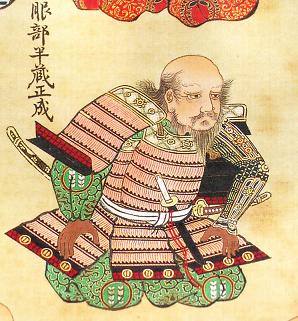

服部半蔵正成 Hattori Hanzo Masanari
1542 ~ 1597
The Legend of Hattori Hanzo Masanari. Japan’s Most Famous Ninja.
Hattori Hanzo Masanari, also known as “Hattori Hanzo” or “Oni no Hanzo,” is a legendary figure in Japanese history. He was a samurai and a ninja. He played an important role in the establishment of the Tokugawa shogunate during the Warring States period (1467-1603) and was known for his skills as a spy, assassin, and samurai, his loyalty to his lord, and his devotion to the art of warfare.
Birth and Training
Hattori Hanzo was born in 1542 in Mikawa Province (present-day Aichi Prefecture). He was born into a family of samurai in the service of the Matsudaira clan, a powerful family that ruled the region. Hanzo’s father, Yasunaga Hattori, was a samurai in the service of the Matsudaira clan.
He became interested in the martial arts at an early age and began training in them. He also trained as a ninja, which became increasingly important during the Warring States period. Ninja were skilled in espionage, destruction, and assassination, and were expected to play an active role as warlords and feudal lords competed for power.
His training as a ninja was rigorous and demanding. He learned how to move quickly and silently, using a variety of weapons and tools, including swords, shuriken, and grass sickles.
Serving the Tokugawa Family
In 1561, when he was 19 years old, he began serving as a vassal to Tokugawa Ieyasu, a minor feudal lord of Mikawa. Ieyasu would later become the most powerful man in Japanese history, and he would play an important role in Ieyasu’s rise to power. Hanzo served Ieyasu faithfully and quickly rose through the ranks to become one of his most trusted advisors.
During the Warring States period, Japan was divided into many small states, and each feudal lord was constantly competing with one another to gain more territory and power. As a vassal of Ieyasu, Hanzo performed a variety of duties, including escort, espionage, and assassination. He was also responsible for teaching other ninja and samurai the art of warfare.
One of Hanzo’s most famous exploits was the Battle of Mikatagahara in 1572. The Takeda clan, led by Shingen Takeda, was facing off against the Tokugawa clan. Hanzo’s fame as a spy and military commander grew from there.
Hanzo continued to serve the Tokugawa family faithfully for many years and played an important role in the unification of Japan under the Tokugawa regime. He was also known as a master of the shuriken, a throwing weapon that became popular among the ninja.
In 1575, Ieyasu was attacked by a rival feudal lord, Takeda Shingen, in the Battle of Nagashino. Hanzo led a group of ninja into the Takeda camp and assassinated several key generals. The Takeda forces were defeated, and Ieyasu was victorious.
Battle of Sekigahara
In 1600, Ieyasu began his campaign to seize control of the country. He assembled a coalition of feudal lords and marched on Kyoto, culminating in the Battle of Sekigahara on October 21, 1600.
Hattori Hanzo also played an important role in this battle. He led a group of ninja to infiltrate the enemy lines and occupy an important position. This allowed the Tokugawa forces to gain the upper hand and win the battle. This battle marked a turning point in Japanese history, as it marked the beginning of the Tokugawa shogunate that would rule Japan for the next 250 years.
Serving the Tokugawa Shogunate
After the Battle of Sekigahara, Hattori Hanzo continued to serve the Tokugawa Shogunate. He was given a fiefdom in Iga Province and appointed head of the “Oniwaban,” the secret police of the Tokugawa Shogunate. His duties included gathering information, maintaining the security of Edo, and guarding the shogun. Hanzo excelled in the martial arts and developed a reputation as a cunning strategist. Hanzo’s reputation became known for his ability to outwit his enemies and his dedication to protecting the shogunate. He was skilled not only in martial arts, but also in strategy and tactics. On the battlefield, he was adept at anticipating the enemy’s movements and making the first move. He was also adept at using deception and misdirection to confuse the enemy.
Death and Legacy
Hanzo’s loyalty to the Tokugawa family was unwavering, and he remained by Ieyasu’s side until Ieyasu’s death in 1616. He himself died a few years later in 1597 at the age of 55. He was buried at Sainenji Temple, which still stands today and is a popular tourist attraction.
Hanzo has been celebrated in popular culture for centuries as a skilled warrior and cunning strategist.
Hanzo has been celebrated in popular culture for centuries as a skilled warrior and cunning strategist. He has appeared in countless movies, TV shows, and video games, and has become a popular character in manga and anime. He has also become a popular character in manga and anime.
The most famous portrayal of Hattori Hanzo is in the 2003 film “Kill Bill,” Quentin Tarantino’s “Kill Bill vol.1,” which was released in 2003. In this film, Hanzo is portrayed as a retired sword smith who creates a special sword for the protagonist, played by Uma Thurman played by Uma Thurman. In addition to his portrayal in popular culture, Hattori Hanzo is remembered as an important figure in Japanese history. Hattori Hanzo served the Tokugawa shogunate and established an era of peace and stability in Japan that lasted for centuries. His legacy continues to inspire people today as a symbol of dedication, courage, and skill.
.
.
.




